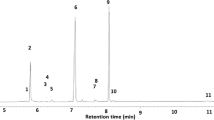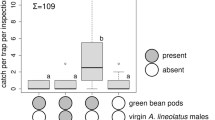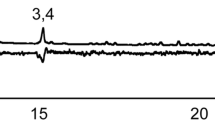Abstract
Porapak Q volatile extracts of female Ascogaster quadridentata, an egg-larval endoparasitoid of codling moth, Cydia pomonella, bioassayed in Y-tube olfactometers attracted male, but not female, A. quadridentata. Coupled gas chromatographic–electroantennographic detection (GC-EAD) analysis of bioactive extracts revealed three compounds that elicited responses by male A. quadridentata antennae. GC-mass spectra (MS) indicated, and comparative analyses of authentic standards confirmed, that these compounds were (Z,Z)-9,12-octadecadienal, (Z)-9-hexadecenal, and 3,7,11-trimethyl-6E,10-dodecadienal. (Z,Z)-9,12-Octadecadienal alone attracted laboratory-reared male A. quadridentata in Y-tube olfactometer and field-cage bioassays, and attracted feral A. quadridentata in a field experiment. This sex pheromone could be used to help detect populations of A. quadridentata, delineate their distributions, and determine potential sources of parasitoids for capture and release in integrated programs for control of C. pomonella.
Similar content being viewed by others
REFERENCES
Arn, H., StÄdler, E., and Rauscher, S. 1975. The electroantennographic detector—a selective and sensitive tool in the gas chromatographic analysis of insect pheromones. Z. Naturforsch. 30c:722-725.
Assem, J. van den. 1986. Mating behaviour in parasitic wasps, pp. 137-167, in J. Waage and D. Greathead (eds.). Insect Parasitoids. Academic Press, London.
Assem, J. van den, and Putters, F. A. 1980. Patterns of sound produced by courting Chalcidoid males and its biological significance. Entomol. Exp. Appl. 27:293-302.
Boush, G. M., and Baerwald, R. J. 1967. Courtship behavior and evidence for a sex pheromone in the apple maggot parasite, Opius alloeus (Hymenoptera: Braconidae). Ann. Entomol. Soc. Am. 60:865-866.
Boyce, H. R. 1936. Laboratory breeding of Ascogaster carpocapsae Vier. with notes on biology and larval morphology. Can. Entomol. 68:241-246.
Brinton, F. E., Proverbs, M. D., and Carty, B. E. 1969. Artificial diet for the mass production of the codling moth, Carpocapsa pomonella (Lepidoptera: Olethreutidae). Can. Entomol. 101:577-584.
Browning, H. W., and Oatman, E. R. 1985. Reproductive biology of Microplitis brassicae (Hymenoptera: Braconidae), parasite of the cabbage looper, Trichoplusia ni (Lepidoptera: Noctuidae). Ann. Entomol. Soc. Am. 78:369-372.
Clausen, C. P. 1978. Olethreutidae, pp. 211-218, in C. P. Clausen (ed.). Introduced Parasites and Predators of Arthropod Pests and Weeds: A World Review. U. S. Dept. Agr., Agri. Handbook No. 480.
Cole, L. R. 1970. Observations on the finding of mates by male Phaeogenes invisor and Apanteles medicaginis (Hymenoptera: Ichneumonidae). Anim. Behav. 18:184-189.
Dool, H. van den, and Kratz, P. D. 1963. A generalization of the retention index system including linear temperature programmed gas-liquid partition chromatography. J. Chromatogr. 2:463-471.
Eller, F. J., Bartelt, R. J., Jones, R. L., and Kulman, H. M. 1984. Ethyl (Z)-9-hexadecenoate, a sex pheromone of Syndipnus rubiginosus, a sawfly parasitoid. J. Chem. Ecol. 10:291-300.
Field, S. A., and Keller, M. A. 1993. Courtship and intersexual signaling in the parasitic wasp Cotesia rubecula (Hymenoptera: Braconidae). J. Insect Behav. 6:737-750.
Finidori-Logli, V., BagnÈres, A.-G., Erdmann, D., Francke, W., and ClÉment, J.-L. 1996. Sex recognition in Diglyphus isaea Walker (Hymenoptera: Eulophidae): role of an uncommon family of behaviorally active compounds. J. Chem. Ecol. 22:2063-2079.
Godfray, H. C. J. 1994. Parasitoids: Behavioral and Evolutionary Ecology. Princeton University Press, Princeton, New Jersey.
Gordh, G., and de Bach, P. 1978. Courtship behavior in the Aphytis lingnanensis group, its potential usefulness in taxonomy, and a review of sexual behavior in the parasitic Hymenoptera (Chalcidoidae: Aphelinidae). Hilgardia 46:37-75.
Heller, S. R., and Milne, G. W. A. 1978. EPA/NIH Mass Spectral Data Base, Volume 2, Molecular Weights 186–273. US Government Printing Office, Washington. p. 264.
House, H. O. 1972. Modern Synthetic Reactions, 2nd ed. Benjamin, Menlo Park, California, p. 93.
Kainoh, Y., Nemoto, T., Shimizu, K., Tatsuki, S., Kusano, T., and Kuwahara, Y. 1991. Mating behavior of Ascogaster reticulatus Watanabe (Hymenoptera: Braconidae), an egg-larval parasitoid of the smaller tea tortrix moth, Adoxophyes sp. (Lepidoptera: Tortricidae) III. Identification of a sex pheromone. Appl. Entomol. Zool. 26:543-549.
Kamano, Y., Shimizu, K., Kainoh, Y., and Tatsuki, S. 1989. Mating behavior of Ascogaster reticulatus Watanabe (Hymenoptera: Braconidae), an egg-larval parasitoid of the smaller tea tortrix, Adoxophyes sp. (Lepidoptera: Tortricidae) II. Behavioral sequence and a role of sex pheromone. Appl. Entomol. Zool. 24:372-378.
Matthews, R. W. 1974. Biology of Braconidae. Annu. Rev. Entomol. 19:15-32.
Miller, M. C., and Tsao, C. H. 1974. Significance of wing vibration in male Nasonia vitripennis (Hymenoptera: Pteromalidae) during courtship. Ann. Entomol. Soc. Am. 67:772-774.
Obara, M., and Kitano, H. 1974. Studies on the courtship behavior of Apanteles glomeratus L. I. Experimental studies on releaser of wing-vibrating behavior in the male. Kontyu 42:208-214.
Pompanon, F., de Schepper, B., Mourer, Y., Fouillet, P., and Bouletreau, M. 1997. Evidence for a substrate-borne sex pheromone in the parasitoid wasp Trichogramma brassicae. J. Chem. Ecol. 23:1349-1360.
Shields, E. J. 1989. Artificial light: Experimental problems with insects. Bull. Entomol. Soc. Am. Summer:40-44.
Sivinski, J., and Webb, J. C. 1989. Acoustic signals produced during courtship in Diachasmimorpha (=Biosteres) longicaudata (Hymenoptera: Braconidae) and other Braconidae. Ann. Entomol. Soc. Am. 82:116-120.
Vinson, S. B. 1972. Courtship behavior and evidence for a sex pheromone in the parasitoid Campoletis sonorensis (Hymenoptera: Ichneumonidae). Environ. Entomol. 1:409-414.
Vinson, S. B. 1978. Courtship behavior and source of sexual pheromone from Cardiochiles nigriceps. Ann. Entomol. Soc. Am. 71:832-837.
Zar, J. H. 1996. Biostatistical Analysis, Prentice-Hall, Upper Saddle River, New Jersey.
Author information
Authors and Affiliations
Rights and permissions
About this article
Cite this article
DeLury, N.C., Gries, G., Gries, R. et al. Sex Pheromone of Ascogaster quadridentata, a Parasitoid of Cydia pomonella . J Chem Ecol 25, 2229–2245 (1999). https://doi.org/10.1023/A:1020813621977
Issue Date:
DOI: https://doi.org/10.1023/A:1020813621977




